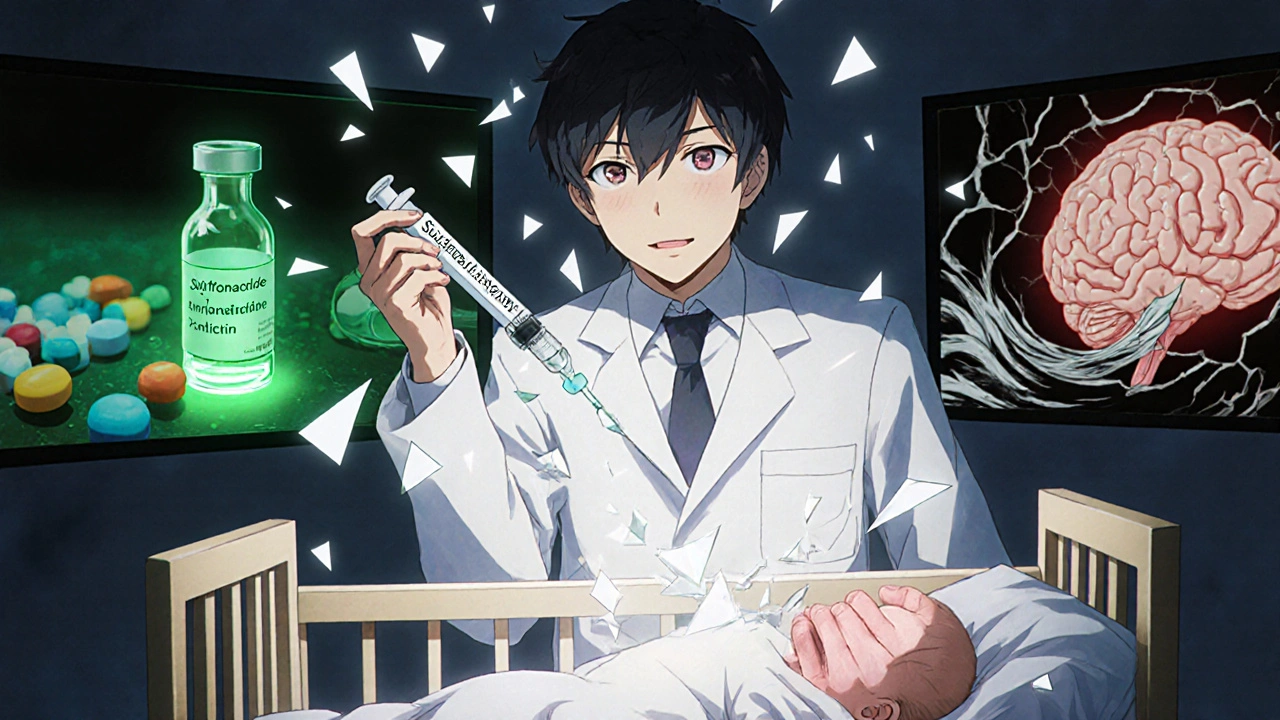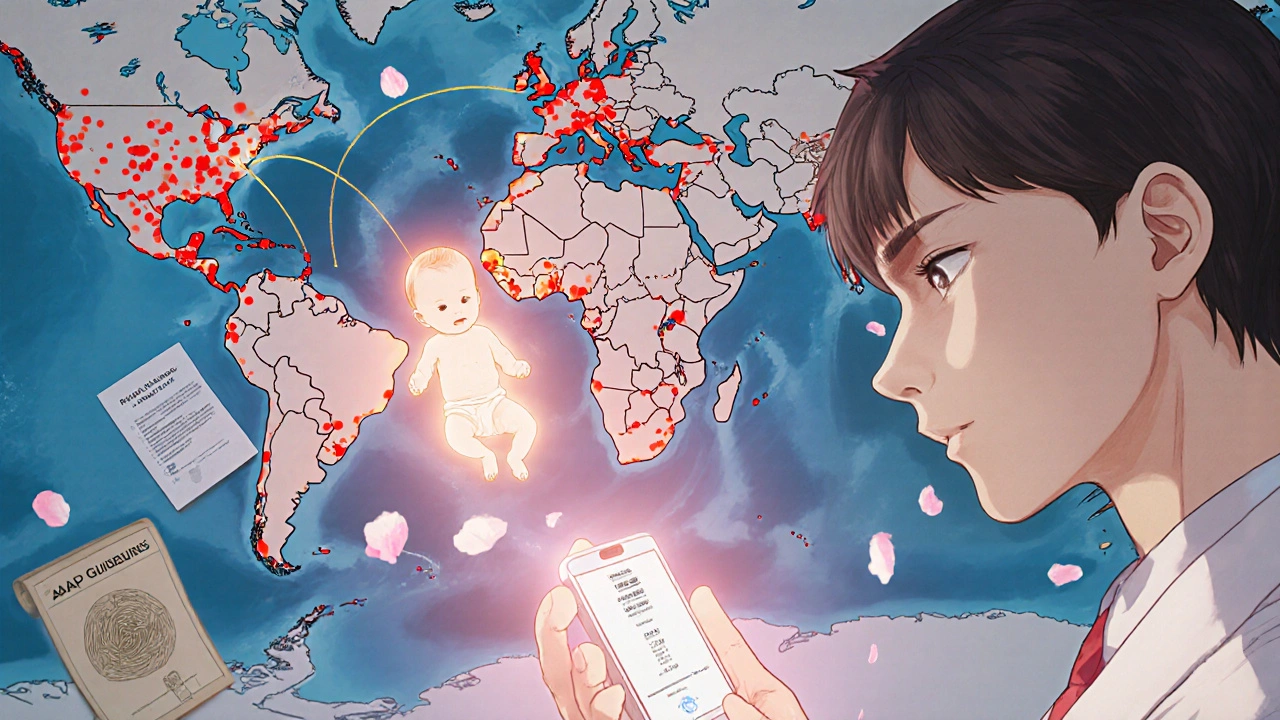
Neonatal Kernicterus Risk Calculator
When a newborn turns yellow, it’s usually just jaundice - common, harmless, and easily treated. But in rare cases, that yellow tint can be the first sign of something far more dangerous: kernicterus. This isn’t just severe jaundice. It’s brain damage caused by bilirubin slipping past the immature blood-brain barrier and poisoning the baby’s nervous system. And it’s almost always preventable - except when medications like sulfonamides are given without checking the bilirubin levels first.
What Is Kernicterus, Really?
Kernicterus happens when unconjugated bilirubin, a byproduct of red blood cell breakdown, builds up in a newborn’s blood and crosses into the brain. It doesn’t happen because a baby is jaundiced. It happens because the bilirubin level gets too high, too fast, and nothing stops it from reaching the brain. The damage is permanent. It can cause cerebral palsy, hearing loss, intellectual disabilities, and even death. The good news? This isn’t a mystery disease. We’ve known how it works since the 1950s. The bad news? It still happens - often because of a simple mistake: giving a baby a medication that pushes bilirubin out of its safe binding spots in the blood.Why Sulfonamides Are Dangerous for Newborns
Sulfonamides - drugs like sulfisoxazole and sulfamethoxazole-trimethoprim - were once common antibiotics for newborns. Today, they’re rarely used, but they still show up in prescriptions, especially in low-resource settings or when doctors aren’t aware of the risk. Here’s why they’re dangerous: bilirubin normally sticks to albumin, a protein in the blood. That keeps it from wandering into the brain. Sulfonamides compete for those same binding spots. At therapeutic doses, they can displace 25-30% of bilirubin from albumin. That means suddenly, there’s a flood of free bilirubin in the bloodstream. In a newborn with already elevated bilirubin - even if it’s just borderline - that’s enough to trigger neurotoxicity. The American Academy of Pediatrics (AAP) updated its guidelines in 2022 to say this clearly: avoid sulfonamides in infants with bilirubin levels approaching phototherapy thresholds. That’s not a suggestion. It’s a warning backed by data. A 2023 review found sulfonamides increase the risk of severe hyperbilirubinemia by 3.2 times compared to safer antibiotics like amoxicillin-clavulanate.Other Medications That Can Trigger Kernicterus
Sulfonamides aren’t the only culprits. Other drugs can do the same thing:- Ceftriaxone: A common IV antibiotic. It displaces about 15-20% of bilirubin. Risk is lower than sulfonamides, but still real - especially in preterm babies or those with low albumin.
- Aspirin (salicylates): Even low doses can displace bilirubin. Never give aspirin to a newborn.
- Furosemide: A diuretic sometimes used for fluid overload. It can reduce albumin binding and worsen bilirubin levels.
- NSAIDs: Ibuprofen and other nonsteroidal anti-inflammatories may interfere with bilirubin metabolism in vulnerable infants.

Who’s at Highest Risk?
Not all newborns are equally vulnerable. The biggest risk factors include:- Preterm infants: Their livers can’t process bilirubin well, and their blood-brain barrier is more permeable.
- Babies with G6PD deficiency: This inherited condition affects about 7% of the global population. These infants break down red blood cells faster, causing bilirubin to spike. Sulfonamides can trigger dangerous hemolysis in these babies.
- Babies with low albumin levels: Albumin below 3.0 g/dL means fewer binding sites. Even normal bilirubin levels can become dangerous.
- Babies with acidosis: Acidic blood reduces bilirubin’s ability to bind to albumin, making free bilirubin levels rise.
What Should Clinicians Do?
The solution isn’t to avoid all antibiotics. It’s to avoid the wrong ones at the wrong time. The AAP recommends a simple 5-step checklist for medication safety in jaundiced newborns:- Check the bilirubin level. If it’s above 75% of the phototherapy threshold for the baby’s age in hours, avoid bilirubin-displacing drugs.
- Check albumin. If it’s under 3.0 g/dL, the risk is higher. Consider alternatives.
- Screen for G6PD deficiency if the baby is of African, Mediterranean, or Southeast Asian descent.
- Calculate free bilirubin if available. Levels above 10 mcg/dL are dangerous.
- Choose safer alternatives. Amoxicillin-clavulanate, cefazolin, or penicillin are far safer for newborns with jaundice.

Real Cases, Real Consequences
A nurse practitioner in Texas shared a case on the AAP forum: a 5-day-old infant with a bilirubin level of 14.2 mg/dL - just below the phototherapy threshold. The baby was given sulfisoxazole for UTI prophylaxis. Within 12 hours, bilirubin jumped to 22.7 mg/dL. Emergency phototherapy and transfer to a NICU followed. The baby survived, but barely. Another case from Reddit’s neonatology community: a late preterm infant with borderline jaundice received sulfamethoxazole-trimethoprim. Two days later, the baby had seizures. Diagnosis: kernicterus. Permanent brain damage. The Birth Injury Justice Center reviewed 120 kernicterus lawsuits. Twelve percent involved inappropriate sulfonamide use. The average settlement? $4.2 million. These aren’t rare anomalies. They’re preventable tragedies.What About Global Access?
In high-income countries, these warnings are widely known. But in low-resource settings, sulfonamides are still used because they cost pennies per dose - about $0.05 - compared to $2.50 for amoxicillin-clavulanate. That’s a big difference when you’re treating hundreds of babies with limited supplies. The National Institutes of Health just funded a $2.4 million project to develop low-cost, point-of-care devices that can measure free bilirubin at the bedside. That could be a game-changer. Until then, the rule is simple: if you don’t have reliable bilirubin testing, don’t give sulfonamides to newborns.The Bottom Line
Kernicterus is not a genetic accident. It’s not bad luck. It’s a failure of protocol - often a single missed check. A medication given without knowing the bilirubin level. A prescription written without checking the infant’s age, albumin, or G6PD status. We have the tools. We have the guidelines. We have the data. What we need now is consistent application. If you’re a clinician: always check bilirubin before giving any drug that binds to albumin. If you’re a parent: ask, “Is this medication safe for jaundiced babies?” Don’t assume it is. The yellow skin of a newborn is usually nothing. But when combined with the wrong medicine, it can be the first symptom of irreversible brain damage. That’s not a risk worth taking.Can kernicterus be reversed if caught early?
No. Once bilirubin has entered the brain and caused damage, the injury is permanent. Treatment like phototherapy or exchange transfusion can prevent further damage, but it cannot undo what’s already happened. That’s why prevention - avoiding high-risk medications and catching high bilirubin early - is the only effective strategy.
Are all sulfonamides equally dangerous for newborns?
Yes. All sulfonamide antibiotics - including sulfisoxazole, sulfamethoxazole, and sulfadiazine - displace bilirubin from albumin. The degree of displacement may vary slightly, but the risk is consistent across the class. Even a single dose can be enough to trigger neurotoxicity in a vulnerable infant.
Is it safe to give sulfonamides to a newborn if bilirubin is normal?
Not necessarily. A bilirubin level that’s "normal" for a healthy baby might be dangerously high for a preterm infant or one with low albumin. The AAP recommends avoiding sulfonamides whenever bilirubin is above 75% of the phototherapy threshold - even if it’s not yet at the treatment level. The risk isn’t just about the number; it’s about the baby’s overall vulnerability.
What should I do if my baby was given a sulfonamide and now seems jaundiced?
Seek medical attention immediately. Do not wait. Request a serum bilirubin test right away. If the level is rising quickly, the baby may need phototherapy or even an exchange transfusion. Time is critical - bilirubin can cross the blood-brain barrier within hours. Inform the provider about the medication given so they can assess risk properly.
Are there any safe antibiotics for jaundiced newborns?
Yes. Amoxicillin-clavulanate, cefazolin, penicillin, and gentamicin are considered safe alternatives. They do not displace bilirubin from albumin and are preferred in newborns with elevated bilirubin levels. Always confirm the diagnosis and choose the narrowest-spectrum antibiotic appropriate for the infection.
